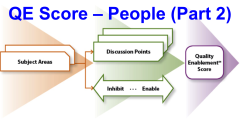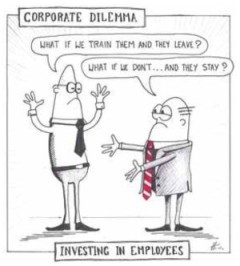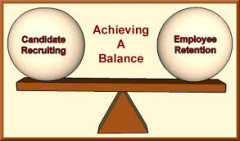… Can be Measured (People Dimension) – Part 2 of 2

“In the end, managers are not loyal to a particular boss or even to a company, but to a set of values they believe in and find satisfying.”
Goran Lindahl, ABB Chief Executive
Last week, we started our examination of the People Dimension measurement process, and looked at the Talent Acquisition and On-Boarding Subject Areas. If those are done well, we’ll have identified the best new team members and properly assimilated them into our organization and teams, and set them up for success.
Today, we’ll discuss what we do to enable them in the long-term.
QE Score Assessment – People Dimension – Part 2 of 2
Training Program

- What training is provided for your job? (enabling) [4]
4 – None
7 – As much as needed to stay current in specialty / business topics
- Does the annual training budget meet the organization’s needs? (enabling) [2]
4 – No training budget
7 – All training needs are met
- What % of the training budget is typically used each year? [3]
1 – <25%
4 – 60%
7 – 100%
- What role does your manager take in the training process? [4]
1 – Approves all training expenses
4 – Includes training in personal development plans
7 – Actively engaged (participates in training, helps develop post-training action plan)
Coaching / Mentoring

- Tell me about the internal mentor program (enabling) [2]
4 – No mentor program
7 – Mentors assigned to all who ask or have advancement potential
- How much job-related coaching do you get? [4]
1 – None
4 – Only at annual performance review
7 – Frequently (at least monthly)
Performance Management

- Tell me about your performance management process [3]
1 – We don’t have any performance management process
4 – We do “normal” annual performance reviews
7 – Frequent feedback, targeted to improve my performance
- What is the approach to frequent performance-related feedback? [4]
1 – Only annually
4 – At least quarterly
7 – At least monthly, both positive reinforcement and improvement guidance
- Tell me about the employee self-review process (enabling) [3]
4 – It’s an annual “drill” – doesn’t add any value to the process
7 – Very valuable – helps guide discussion, and helps me get better
- What is your involvement in creating your performance goals? [4]
1 – No involvement on my part
4 – I have some say in some of the goals, but not all of them
7 – I’m actively involved in establishing my goals; they accurately represent my job
- How often do you get positive feedback from your manager throughout the year? (enabling) [4]
4 – Rarely / never
7 – Frequently – at least monthly
- How well does your manager understand your career ambitions? (enabling) [2]
4 – We’ve never discussed it
7 – He helped me plan and is actively involved helping me get ready for the next position
- What is typically done with workers who are not at the desired performance level? [3]
1 – They get fired; or they’re kept and bring down the team
4 – They’re put on a performance plan and usually resign
7 – My manager works with them to correct, helps find a position where they can succeed
- How do you typically feel after you receive your feedback? [4]
1 – I feel terrible, a failure, that there’s no future for me at this company
4 – I feel OK – it’s a ritual we need to go through, but it neither encourages me or discourages me
7 – I feel great, and look forward to the feedback; it helps me get better and advance my career
- Does the feedback typically make you want to stay or leave? [4]
1 – It makes me want to leave
4 – It has no impact on my desire to stay or leave
7 – It makes me want to stay, because I know I’m adding value and doing meaningful work, and I can see a good future for me here
Management (immediate supervisor)

- What does your manager do that specifically enables your effectiveness? (enabling) [4]
4 – Nothing
7 – Coaching, mentoring, listens to ideas, implements suggestions, etc.
- What does your manager do that specifically inhibits your effectiveness? (inhibiting) [4]
1 – Public chastising, yelling at me, grossly overworked, etc.
4 – Nothing
- How would you describe your manager’s typical feedback to you? [3]
1 – Only negative, or none
4 – Mixed – some positive, some negative
7 – Frequent – constructive to help me develop, positive to recognize accomplishments
Senior Management (those senior to immediate supervisor)
- What do senior managers do that specifically enables your effectiveness? (enabling) [4]
4 – Nothing
7 – Actions that show they care, and address issues to help us succeed
- What do senior managers do that specifically inhibits your effectiveness? (inhibiting) [4]
1 – Actions that show they don’t care; frequent direction changes
4 – Nothing
- How would you describe typical feedback you receive from senior managers? [3]
1 – Only negative, or none
4 – Mixed – some positive, some negative
7 – Frequent – constructive to help me develop, positive to recognize accomplishments
Retention

- What, if any, active programs improve worker retention? (enabling) [3]
4 – None
7 – Flexibility, listen to my ideas, make me feel appreciated, etc.
What’s Next
Next week, we’ll continue the QE Score assessment process with the Process Dimension.
Until Then …
“Insanity: doing the same thing over and over again and expecting different results.”
Albert Einstein

What are your thoughts? Please share your comments in the block below.